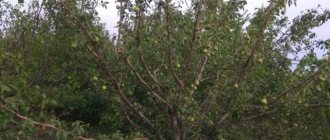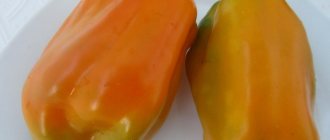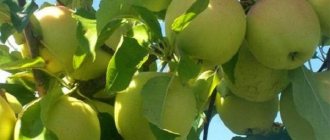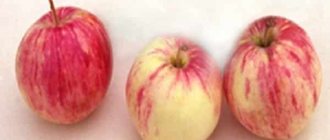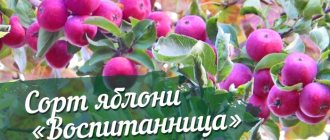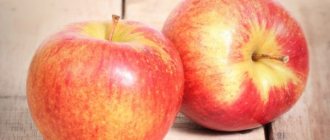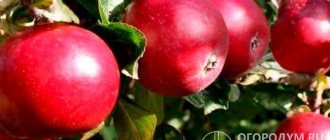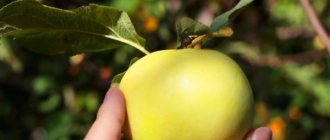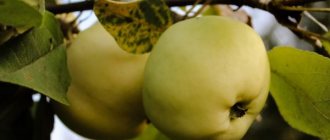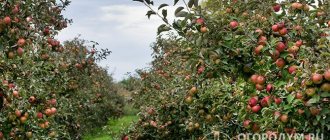Characteristics
The apples look quite attractive. They have a smooth surface, irregular shape and unequal sides. Their hue is green-yellow and turns golden over time. Where sunlight hits the fruit, a nice light blush appears.
Advantages and disadvantages
There are a number of advantages for which gardeners and gardeners value this variety. Some of them are worth mentioning:
- long-term storage of fruits, until next summer under proper conditions;
- high resistance of apple trees to fungal diseases;
- high yield, large fruit size;
- the ability to transport apples over long distances without loss of taste and appearance.
To be fair, the downsides must also be taken into account. More precisely, there is one significant drawback: the tree bears fruit periodically, it needs a year of rest. During severe epidemics, powdery mildew may appear on the apple tree.
Dimensions of an adult tree
Without proper shaping, the tree grows up to 6.5 meters. But usually the crown is formed at a level of 4-5 meters. This height of the apple tree will be preferable and convenient for caring for it and collecting fruits.
Apple tree Golden Ranet.
Annual growth
The tree grows quite quickly. The annual growth should be about 60 centimeters. If this indicator is different, then this may be evidence of disease or pest exposure.
Frequency of fruiting
A distinctive feature of this variety is the frequency of fruiting. The tree needs rest for a year, during which it accumulates useful substances and strength. And also in the year of rest, the apple tree strengthens its immunity.
Productivity
The Golden Ranet variety is distinguished by its high yield. The average is 200 kg or more. However, do not forget that the apple tree reaches this indicator every year.
Tasting assessment
On a generally accepted scale out of 5 possible, the tasting rating of the variety is 4.2 points. But the fruits of the tree are very tasty and juicy.
Winter hardiness
This indicator is also what gardeners look for first. The winter hardiness of the apple tree is very high, even practically the highest among many species. The golden ranet does not freeze even in the harshest winters.
Disease resistance
The Golden Ranet is quite resistant to scab. But during epidemics it may suffer from powdery mildew. Regular spraying will be enough to protect the apple tree from various diseases.
Features and characteristics
- In general, the variety demonstrates a number of positive qualities, in particular:
- high productivity;
- large-fruited (each apple weighs about 250 g);
- good shelf life and transportability of the crop;
- average resistance to cold and common diseases (powdery mildew, scab).
The tree is self-fertile and begins to bloom in late spring. Around this period, the previous year's harvest may be preserved under favorable conditions. It is typical that over time, during storage, the acidity and astringency in the taste are lost - it is replaced by freshness.
If you follow agrotechnical growing rules, you can collect up to 200 kg of fruit from each apple tree.
However, a significant drawback of the variety is its frequency of fruiting. The dormant period can last for several seasons. This nuance should be taken into account by gardeners who cultivate apple trees for income.
- In addition, the weaknesses of the Golden Ranet are called:
- high sensitivity to drought;
- weak resistance to black cancer;
- poor heat resistance;
- the tree is tall (develops up to 7 m in height), which makes harvesting difficult.
Did you know? The largest European exporter of apples is Poland, and the world leader is China.
Analyzing the fruit and vegetable market, experts came to the conclusion that modern varieties of apples are more adapted to the needs of consumers, and the Golden Ranet, despite its high yield, is not used in horticulture. This explains the territorial narrowing of the cultivation of this variety.
Features of planting and care
The apple tree does not require any special technology for planting or care. All standard procedures that are necessary for other varieties are suitable for the unpretentious Golden Ranet.
Landing dates
The tree can be planted in the fall, but it is optimal to do it in the spring. This way it can strengthen before the cold weather begins. Planting should usually be done at the end of April or beginning of May, depending on climatic conditions. It is necessary to plant before the sap begins to flow.
Planting the Golden Ranet apple tree in autumn.
Scheme
If the apple tree is planted as a single tree, then it can be left a little room to grow, keeping a distance from other trees, 3.5 by 4.5 meters. But if several apple trees are planted in a row, then planting can be done more compactly, according to a 3.5 by 3 meter pattern.
Agricultural technology and cultivation
The Golden Ranet apple tree is grown in the same way as any other. Important agricultural practices include:
- regular and timely watering - 3-4 times per season;
- fertilization;
- crown care, which includes shaping;
- tree care to prevent pests and diseases.
Standard procedures will help maintain the health of the tree. However, their implementation is mandatory.
Pruning and crown formation
Sanitary pruning is a necessary procedure in which it is necessary to remove damaged, frozen or infected parts of the shoots.
Formative pruning is also carried out regularly. It is important to ensure that the crown is compact and the tree does not stretch out.
These two procedures can be combined, at the same time caring for the crown and adjusting the growth height of the tree. By performing them, you can achieve large, high-quality fruits on a healthy, beautiful tree.
Pollinator varieties
The Ranetka golden apple tree is self-fertile and can be pollinated by its own pollen. But if insects participate in this process, then the percentage of ovaries will be much higher, and accordingly there will be more fruits.
Sequence of care
Golden ranet, in addition to traditional procedures, requires constant stimulation of yield and crown formation. In this way, the gardener can make the harvesting process easier and increase the productivity of the tree.
Watering, loosening and fertilizing
The level of its yield and the quality of the fruit, as well as the longevity of the plant, depend on the condition of the soil under the apple tree, so it is important to weed and loosen the substrate as weeds appear. This manipulation will allow the crop to fully develop, rid it of competitors for nutrients in the soil and improve the aeration of the root system.
It is unacceptable for the Ranetka apple tree to end up in a swampy environment. Prolonged drought can also harm it, so when watering it is recommended to take into account weather conditions, the location of groundwater and the age of the apple tree. In general, young seedlings should be moistened at intervals of 2-3 weeks, pouring up to 2 buckets of settled water warmed to room temperature under each tree.
The first moisturizing procedure in the garden is relevant in the spring, before the leaf buds open. The second time, mature trees (which are more than 5 years old) are watered after they bloom, as well as during the period of fruit set. For two-year-old specimens, about 4 buckets of water are used, and for old apple trees it is recommended to pour up to 10 buckets.
The last watering is carried out after harvesting. After each moistening, it is necessary to destroy the hard earthen crust formed in the tree-trunk hole with a hoe. The damp soil is then mulched with sawdust, straw, grass clippings or peat.
Important! Coniferous material is not suitable as mulch for apple trees, since during the decomposition process it oxidizes the soil.
In the spring, at the beginning of the growing season, it is important to apply nitrogen-containing substances under the roots of the tree, which stimulate the growth of biomass. For this, gardeners most often use a solution of chicken manure prepared in a ratio of 1:50.
When greenfinches begin to form on the tree, you need to water it with a nutrient mixture of:
- nitroammofoski (30 g);
- ammonium nitrate (30 g);
- calcium chloride (45 g);
- superphosphate (150 g);
- water at room temperature (10 l).
To stimulate winter-hardy qualities, Golden Ranet can be fed with complex mineral fertilizers (make sure that the packaging is marked “Autumn”), or with a solution of superphosphate (50 g per 1 liter of water).
Before winter, organic matter and nitrogen should not be used. Otherwise, the tree will greatly grow young branches, which will die at the first frost. After the resulting stress, the apple tree may not survive the winter.
Crown formation and pruning
Due to its tall growth, the Golden Ranet requires annual pruning. With proper care, the height of the tree can be shortened to 4 m without harming its fruiting qualities. Every year in the spring, before active circulation of juice begins, it is important to remove all old, dry, frostbitten, broken and diseased branches from a mature apple tree. Regular sanitary pruning is one of the effective ways to protect a tree from the development of diseases.
Did you know? The area of all apple orchards on the planet is about 5 million hectares.
If you monitor the growth of branches and correctly form the crown, you can prevent its thickening and increase productivity. To do this in the fall, when the leaves fall and the weather gets colder, you need to remove the shoots that grow inside the crown and create shade. One of the competing young shoots must also be removed. In young specimens, the lateral branches of the main trunk and the top are cut off at the level of 80 cm.
Pruning is carried out with sharp pruning shears. After the procedure, the cut sites must be treated with garden varnish. When removing large branches, it is appropriate to wrap the wounds with polyethylene, securing its edges with electrical tape.
Preparing plantings for winter
In areas with a mild climate, the Zolotoy Ranet variety can winter painlessly, without requiring additional preparation for cold weather. In regions with harsher winters, it would be a good idea to cover young (up to five years old) seedlings for the winter.
To this end, the gardener needs:
- mulch the tree trunk circles with a thick layer (up to 15 cm) of peat, retreating about 10 cm from the trunk;
- wrap the trunk and crown of the seedling with thick fabric;
- tie the trunk to a height of 50 cm with spruce branches.
This will help prevent attacks from hungry rodents.
Prevention of diseases and pests
During epidemics, apple trees can demonstrate high vulnerability to pathogens of scab and powdery mildew, therefore, for preventive purposes in early spring, disinfecting trees with a solution of copper sulfate (50 g per 1 liter of water) will not hurt.
As an alternative, you can use potent chemicals: “Hom”, “Skor”, “Fundazol”, “Albit”. These are fungicides that are effective in the fight against fungal diseases (scab, rust, powdery mildew, cytosporosis).
It is advisable to use them in dry, windless weather, preferably in the morning or evening. In case of attacks by harmful insects (aphids, leaf rollers, moths, mites), insecticides (Aktara, Actellik, Ampligo, Eggio, Match) will come to the aid of the gardener.
Features of ripening and fruiting
There are some fruiting features that you need to know before planting an apple tree of the Golden Ranet variety.
Beginning of fruiting
Typically, the variety begins to bear fruit in the fifth or sixth year after planting. But on dwarf rootstocks, an apple tree can bear fruit already in the third year.
Fruits of the Golden Ranet apple tree.
Peculiarities
Apple picking takes place in early October. The fruits ripen together, almost at the same time.
Flowering time
The tree blooms in late May, but continues flowering until mid-June. Thus, flowering can be characterized as mid-early.
Fruit ripening
The fruits are harvested approximately at the end of September – beginning of October. But depending on climate conditions, it may start a little earlier or end in mid-October.
Apple storage
The shelf life of apples is a special advantage of this variety. They can retain their taste for six months and even a little longer. We can safely say that the fruits are stored until the next season.
Description
The Golden Ranet apple tree is one of the old Russian varieties .
Distributed in:
- Kursk region,
- Volga region,
- And also in the northeastern part of Ukraine.
Medium sized tree. The yield is high. Fruiting occurs in periods. It has good resistance to scab and is slightly damaged by powdery mildew.
Golden ranet is an old Russian variety.
The Golden Ranet apple tree variety has a late ripening period and is therefore considered a winter variety:
- The fruits are unequal, simplified.
- They have a smooth surface.
- The color of apples ranges from light green to yellowish green.
- When exposed to sunlight, a slight blush forms on the apples.
- Under storage conditions, the fruits acquire a slightly golden color and an attractive appearance.
- The seed nests and hearts of the fruits are large. The seed chambers are slightly open.
- The pulp is white, slightly dense.
Golden ranet
There are several varieties of options for growing the Golden Ranet variety.
Columnar
It is very convenient to grow columnar apple trees; they are easier to care for and take up less space. But the Golden Ranet is not grown in a columnar form.
Apple tree Golden Ranet columnar.
Livlyandsky
This representative of Raneta is a universal early winter variety.
It is slightly different from Gold:
- medium-sized fruits weighing up to 100 grams;
- green skin color;
- sweet taste of fruit.
Apple tree Golden Ranet Livlyandsky.
Otherwise, the apple tree is similar to the Golden variety, it is resistant to cold and the fruits can be stored for a long time.
Chinese
This variety is also one of the oldest and very famous. Its features are:
- high winter hardiness;
- early onset of fruiting, from the third year of life;
- delicious fruits.
Apple tree Golden Ranet Chinese.
Although Kitayka golden is an early variety and the fruits are harvested in September, they are perfectly stored for a long time.
Kursk
The ancient variety Kursk Ranet, like its close relatives, can bear fruit at the very end of September and until mid-October. Fruits are stored for a very long time, until March - April.
Apple tree Golden Ranet Kursky.
Variety of varieties
Columnar apple tree Golden Ranet: video about the variety
Livlyandsky.
- The apple tree variety Golden Ranet belongs to the early winter species.
- The taste of the fruit is sweet.
- The size of the fruit is small, the fruit weighs no more than one hundred grams.
- Golden ranet apples are round, the color is green, the internal contents are white.
- The crop can be stored for a long time.
- The variety has a high level of resistance to the winter season.
- This variety is universal in purpose.
Chinese.
This Golden Ranet apple tree is an old variety that ripens early. It is distinguished by a high level of resistance to winter, good taste of fruits that are stored for a long time and ripen early. The apple tree begins to bear fruit in the third or fourth year.
Kursk.
The same applies to old apple varieties. The fruits ripen in the last September to first October days. Apples are stored for a long time - until the first month of spring.
Growing in regions
The winter-hardy variety feels comfortable in many regions. This is possible due to its unpretentiousness and resistance to extreme cold.
Moscow region
The golden ranet feels great throughout the Moscow region. It easily adapts to climate conditions and does not respond to lower temperatures. Scab practically does not appear here, but sometimes powdery mildew infection occurs.
Belarus
Grown on the territory of Belarus, the Golden Ranet fully displays all its qualities. But sometimes he suffers from the appearance of scab.
Reviews
Christina. “Golden Ranet is a very good variety for me . We bought it after seeing the description and photo. The apple tree has excellent winter hardiness.
Delicious and beautiful fruits . Sometimes the tree can rest, but is unpretentious in care. I like."
Matvey. “The apple tree has a lot of positive reviews. My review also applies to them. Very tasty and beautiful fruits with a golden hue .”
Yuri. “There are two Golden Ranet trees in my garden. I am very pleased with the variety; the photo and description of the variety did not deceive me.
The apple tree tolerates almost any low temperature . In any case, I have never been frozen. My parents also have a couple of trees of this variety. Everyone loves this variety. Children love apples."
More on Tele4n.Net:
Apple tree Jonagold: description, photos, reviews
Causes of poor growth
Even this unpretentious variety can slow down in growth or stop altogether. There may be several reasons for this.
- Incorrect landing. It is necessary to plant the seedling so that the root collar is not buried.
- Manifestation of diseases. Infected planting material is often sold, so you should choose responsibly.
- The appearance of pests. Harmful insects often appear on young apple trees. If they are not removed in a timely manner, the seedling will slow down and may even die.
That is why from the very beginning of planting it is necessary to follow all the rules of agricultural technology.
RENET GOLDEN BULL (Bull's golden pippin, Bull's golden Reinette, Pepin d'or de Bull, Reinette dorée de Bull)It is believed that the birthplace of this variety is England. We were unable to find further details on the origin of this renet.
The fruit is beautiful, medium in size, sometimes large, truncated-conical in shape, ribbed, its appearance reminiscent of Renet of Blenheim. The saucer is spacious and deep, with folds and ribs. The stalk is thick, with a bell at the upper end, very short, hidden in a wide and deep funnel.
The skin is smooth, slightly oily to the touch, golden yellow; on the sunny side of the fruit there is a pale carmine-red blush and speckles and dots of the same color are scattered.
The pulp is fragrant, yellowish white and dense, quite tender, juicy, sweet, with slight acidity, very tasty.
The tree has good vigor, is healthy and productive.
RENET GOLDEN WEIDNER (Haffner's Gold-Reinette, Reinette dorée de Weidner, Reinette Weidner, Weidner's Gold Reinette)
The originator is the miller Weidner (near Nuremberg, Germany), who in 1844 developed this variety from the grain of Renet of Orleans. The first distributor of the described variety was the pepinierist Gaffner, who renamed it Gaffner's Golden Renet.
The fruit is medium-sized, heavy, flat-spherical in shape. The saucer is wide, shallow, and has folds. The stalk is thick, with a bell at the upper end, not long, arched, almost does not protrude beyond the boundaries of a rather spacious, but not deep funnel, lined with a layer of delicate rust.
The skin is dry to the touch, golden-yellow, washed with a light carmine-red blush on the sunny side and streaked with specks of the same color; the entire field of the fruit is dotted with small dark and light dots.
The pulp is yellowish, white, juicy, very tender and sweet, with a pleasant wine flavor.
The tree is small, frost-resistant, forms a branched, flat-spherical crown; characterized by unpretentiousness. enters the fruiting season early. The flowering period is mid-early.
RENETTE GOLDEN VERSAILLES (Graue Champagner Reinette, Lemon peppin, Reinette orgentee, Reinette dorée de Versailles, Reinette grise de Champagne, Versaillaise Reinette)
The variety is French, probably originating in Champagne around 1730. Currently, it is very common in gardens throughout the continent, as well as in England and America.
The fruit is small or medium in size, sometimes slightly ribbed, flat-spherical, often not entirely symmetrically constructed. The saucer is very spacious. shallow, sometimes in small folds and fleshy tubercles. The peduncle is thick, with a bell at the upper end; sometimes at its base there is a rather large fleshy outgrowth; it is so short that it usually hides in a spacious and rather deep funnel.
The skin is slightly fragrant, rough and dry to the touch. yellowish, sometimes golden-yellow with a slight blurry orange-red blush on the illuminated side; dark dots of various sizes are scattered throughout the fruit.
The pulp is fragrant, yellowish, loose, tender, juicy, very sweet, almost without any acid in taste.
The tree is of medium vigor, forms a slender trunk, which is crowned with a very branched crown. It prefers light soil and bears fruit generously.
RENET GOLDEN HEISGENS (Heusgens Gold-Reinette, Peter Heusgens Gols-Reinette, reinette Peter Heusgens Gold)
The originator is Konrad Genzen (Germany), who dedicated this variety to the pomologist P. Geisgens. The original self-rooted tree produced its first harvest in 1870.
The fruit is beautifully colored, very slightly ribbed, medium-sized or large, flat-spherical. appearance somewhat reminiscent of Renet Buamana. The fruits are firmly attached to the tree and are often affected by scab. The saucer is spacious. quite deep. in folds, surrounded by raised bumps along the border. The peduncle is thick, then short. sometimes it is long and sometimes almost does not protrude beyond the boundaries of the spacious and deep funnel. the walls of which are lined with a layer of rust.
The skin is smooth, shiny, thin, dense, golden-yellow, sometimes almost the entire field of the fruit is filled with a brilliant blood-red blush, against which dots of a denser shade appear.
The pulp is yellowish, loose, juicy, wine-sweet.
The tree is vigorous, durable, undemanding, and forms a highly pyramidal crown; In the East it begins to grow late in spring and is distinguished by early and generous yields. The flowering period is late.
RENET GOLDEN GESDONSKY (Gesdonsky golden renet, Gäsdonker Gold-Reinette, Reinette de Gäsdonk, Reinette Gäsdonk doreé)
The variety was probably bred at the beginning of the 19th century. in the Gesdonk garden near the city of Goch on the Rhine (Germany), from where Diehl received and described it.
The fruit is small, sometimes medium in size, quite regularly built, flat-spherical in shape, like “short-legged”, and holds firmly on the tree. The saucer is wide, deep, with folds. The stalk is thick, short, and almost does not protrude beyond the boundaries of a rather spacious, but not deep funnel, the walls of which are lined with a layer of rust.
The skin is rough, somewhat thick, golden yellow, in well-lit fruits with a slight dull blush on the sunny side; the entire surface is dotted with numerous brown and light gray dots.
The pulp is yellowish, quite dense, juicy, with a pleasant wine-sweet taste.
The tree is frost-resistant, healthy, of medium vigor. Forms a spherical crown. It was not demanding on the soil, but it was quite moist. It enters the fruiting period early, gives birth constantly and very gratefully. The flowering period is quite late, the flowers are not sensitive to adverse weather conditions.
GOLDEN RENET FROM VITRO (Aurore, Calville jaune tardive, Duhamel Goldreinette, Dundee, Geele Renet, Golden pippin, Megginch Favorite, Princesse Noble, Reinette tulipe, Wygers, Yellow german, Reinette d'Aix)
The oldest variety, apparently of French origin. In France it was cultivated already in the first half of the 17th century; in England it is also very common and in 1676 was already highly valued.
The fruit is beautiful, medium in size, truncated-conical or spherical in shape. The saucer is large and shallow. The peduncle is not very thick and is sometimes short, sometimes longer; the funnel is deep, spacious, sometimes cramped.
The skin is smooth, tender, thin, lemon-yellow, densely dotted with brown dots, and on the sunny side with a golden tint; sometimes a small but bright orange-red blush appears.
The pulp is fragrant, yellowish-white, with green veins, tender, very juicy and sweet, with a very weak acidity in taste, but this almost disappears as the fruits reach full maturity.
The tree is healthy, of medium vigor, develops slowly; it is not particularly demanding, but prefers light soil. Flowering period is mid-early; the flowers are large. pale pink. The yield is regular and rewarding.
RENETTE GOLDEN FROM GOYA (Hoya Golden Reinette, Hoyasche Goldreinette, Reinette de Hoya, Reinette Hoyaische Gold)
According to Oberdieck, this is a Dutch variety, and he distributed it under the name Renet golden Goya temporarily until the original name of this variety was established.
The fruit is beautiful, of good medium size, symmetrically built, spherical in shape, truncated at both poles, and in general, in its appearance it resembles Renet d'Orléans. The saucer is small and shallow. The stalk is not thick, moderately long and protrudes slightly beyond the spacious and not very deep funnel, which is sometimes lined with a layer of rust.
The skin is slightly fragrant, somewhat hard to the touch, thin, shiny, golden yellow; it is washed with a wide orange-red blush and densely streaked with carmine-red stripes, and also dotted with star-shaped dots and spots of soft pink color.
The pulp is fragrant, yellow, tender, quite juicy, with a pleasant wine-sweet taste.
The tree is healthy, large, develops quite quickly, forms a flat-spherical crown with numerous thin hanging branches. Needs a warm position and good soil, enters the fruiting season early, and gives birth very generously. The flowering period is early.
RENET GOLDEN FROM DIEZ (Dietzer Gold-Reinette, Dietzer rote Mandelreinette, Dietzer Winter Gold-Reinette, Reinette dorata di Dietz)
The originator is Bieber (Dietz, Germany), who developed this variety from the grain of Borsdorf noble. By sowing, he had in mind to obtain Borsdorf noble trees, but, of course, his expectations were not met, since not a single one of the sown grains reproduced the mother variety.
The fruit is beautiful, small or medium in size, truncated-conical or almost short-cylindrical. The saucer is spacious, flat, with folds. The stalk, thick, short or moderately long, curved, is placed in a spacious but not deep funnel, lined with a layer of rust.
The skin is slightly hard to the touch, golden-yellow, with rusty veins and spots, the sunny side of the fruit is washed with a shiny light carmine blush and dotted with the same stripes, and white spots are scattered throughout its field, which sometimes have a dark center.
The pulp is fragrant, yellowish-white, tender, juicy, wine-sweet, with a characteristic spice in taste.
The tree is healthy, develops quite quickly and strongly, forms a highly spherical crown, and reaches large sizes with age. It does not like dry soil, enters the fruiting season early and gives birth gratefully. The flowering period is quite late.
RENET GOLDEN KURSKY (Winter golden renet, Zolotarevka, Renet Zolotarevsky (in Semirechye), Rogulevka)
This renet has been cultivated in the Kursk province for a long time; As an industrial variety, it is especially widespread in the gardens of Korochansky district. The question of its place of origin remains open: we have no objective evidence in favor of it. that this variety was actually bred in the Kursk province, although this is permissible. It is also possible, however, that in ancient times it was brought from somewhere to the Kursk gardens, but where from is unknown.
The fruit is beautiful, of good medium size, sometimes large, slightly ribbed, bluntly spherical in shape. The fruits are firmly attached to the tree. They are very different in size and are not of the same type, due to which, during sorting, a lot goes into the second grade. The saucer is small, shallow, slightly ribbed. The stalk is not very thick, with a bell at the upper end, long, curved and extends beyond a rather deep but narrow funnel, the walls of which are sometimes lined with a layer of rust.
The skin is very faintly scented, dense, shiny, yellowish with a more or less wide blurred and striped blush on the illuminated side.
A tree of good growth vigor. At -30°C frost, its wood freezes more or less strongly. It forms a pyramidal crown, enters the fruiting season quite early and in unplanted gardens it gives birth regularly and very gratefully year after year.
zoned: Russia - Belgorod, Volgograd regions; Ukraine - Chernigov region; Kyrgyzstan.
RENETTE GOLDEN PISGOUD (Incomparable Peasgood, Renet Peasgood, Peasgood's nonesuch, Peasgood's Sondergleichen, Reinette doreé de Peasgood, Sanspareille de peasgood)
Originator: Peasgood (Stamford, England). He developed this variety from the grain of Aporta Alexander. In 1872, the Royal Horticultural Society in London awarded the fruits of Renet golden Peasgood a first class certificate. In 1874 this new variety began to be distributed by the firm of W. and D. Brown; in the last decade it has become widespread in our home gardens, so it is not very rare in the Kyiv province.
The fruit is magnificent, large, and on dwarf rootstocks sometimes reaches enormous size and considerable weight; the shape of the fruit is spherical-truncated, somewhat tapering towards the toe; More or less significant warty formations often appear on its surface. The fruits are single-sized, easily knocked down by the wind, and often rot on the tree in rainy summers; When lying down, they are often affected by subcutaneous spotting. The saucer is wide, deep, with five relief folds. The stalk is thick, with a bell at the upper end, sometimes very short, sometimes relatively long and then freely protruding beyond the limits of a spacious and deep funnel, the chambers of which are often lined with a layer of rust.
The skin is fragrant, oily to the touch, luxuriously colored. A bright pink blush is spread across its golden-yellow field, against which wide, light and dark dots appear; the entire surface of the fruit is enveloped by a light layer of delicate matte coating, which enhances the attractiveness of this fruit.
The pulp is yellowish-white, loose, quite juicy, sweet, with a slight acidity in taste.
The tree is vigorous, healthy, frost-resistant, forms a wide, slightly branched, sparse crown; Requires a sunny and wind-protected position, as well as good, nutritious and not dry soil. Fruiting occurs quite early; the yield is neither generous nor constant. The flowering period is early and long; the flowers are somewhat sensitive to frost and this, to some extent, is the reason for the low yield of the variety.
zoned: Russia - Krasnodar, Stavropol Territories, Rostov Region, Kalmykia.
RENET GOLDEN REDER (Reders Gold Reinette, Reinette Reders Gold)
Originator: Heinrich Raeder (Germany). He developed this variety from the grain of the Parmena golden winter fruit, sown in 1869, and the original rooted tree brought its first harvest in 1882. Reder's Golden Renet was first described by F. Lucas, who also gave a chromolithographic drawing of this fruit.
The fruit is beautiful, of good medium size or large, symmetrically built, obtuse spherical in shape. In the toe area, the surface is lumpy and weakly defined flat ribs originate there. The fruits are set in shoots, sometimes 5-6 pieces each. The saucer is very wide, with folds, and sometimes ten symmetrically diverging relief rays branch from a very large and open cup, forming a beautiful rosette. The stalk is very thick. sometimes long, sometimes short, and usually protrudes freely beyond the boundaries of a rather shallow and not very wide funnel, the walls of which are often lined with a layer of rust.
The skin is slightly oily to the touch, smooth, shiny, pale yellow, sometimes golden and washed with an appetizing carmine-red blush, against which speckles of a denser shade and numerous small white dots emerge.
The pulp is fragrant, yellowish-white, loose, somewhat coarse-grained, juicy, sour-sweet. The pulp of cut fruits retains its natural color for a long time and does not darken. The grains are wide, long, very large.
The tree is fast-growing, medium-vigorous, frost-resistant, forms a wide-pyramidal crown; enters the fruiting season early and gratefully gives birth in a year. It is not demanding on soil conditions, but the flowers are especially sensitive to unfavorable weather conditions.
RENETTE OF CUSY (Carrée, Cuzy-Reinette, Reinette d'Angleterre, Reinette de Bourgogne, Reinette carrée de Montbart)
According to A. Leroy, this variety has been bred in France for several hundred years. It was discovered in a garden in the village of Chanois in the Saône-et-Loire department. Now in western and central France, Reinette from Cuzy also continues to be cultivated as a tasty market variety.
The fruit is medium in size. sometimes quite large and correspondingly heavy; spherical or truncated-conical in shape, ribbed; The fruits are most often set alone and are held quite firmly on the tree. The saucer is very spacious, deep in relief folds. The peduncle is thick. with a small bell at the upper end, short, arched, sometimes completely hidden in a fairly capacious and deep funnel, the walls of which are lined with a layer of rust.
The skin is smooth, tender, shiny, lemon or golden yellow, sometimes browned on the sunny side; the entire field of the fruit is densely dotted with large rusty and white dots, some of which have a dark center.
The pulp is yellowish-white, tender, juicy, sweet. with a slight pleasant acidity in taste.
The tree is of medium strength, healthy, frost-resistant, prefers light soils; enters the fruiting season early and develops very rewarding productivity. The flowering period is late, the flowers are medium-sized, pinkish-white.
RENET FROM SYKE-HOUSE (Angolkorhaz renet, Culver Russet, Englische Spital-Reinette, gelbe Reinette, Kleine graue Reinette, Pome de Syke-House, Prager, Syke-House Russet, Pomme de anglais)
English variety. bred at the beginning of the 19th century; it bears the name of the village of Syke-House, in Yorkshire, in one of whose gardens it saw the light. Diehl was sure that this renet arose from a grain of Pepin English. With the light hand of this glorious pomologist, who, through a misunderstanding, mistook his own name Syke-House for Suck-house, which can perhaps be translated by the word “hospital” or “hospital”, the incorrect German name of the variety English Hospital Renet, by which this variety is known in Germany, and then the incorrect French Hospital Renet, and finally the Russian - Hospital Renet.
The fruit is medium in size. correctly, flat-spherical in shape, slightly flattened at the poles. The saucer is spacious, shallow, and rusty. The peduncle is thick, short, and at its base there is sometimes a small, fleshy outgrowth; it protrudes slightly beyond the boundaries of the deep and narrow funnel, lined with a layer of rust, but more often it completely hides in it.
The skin is slightly fragrant, rough and dry to the touch, thin, lemon-yellow, and on the sunny side of well-lit fruits sometimes a slight blush appears, and the entire field is occasionally dotted with brown gray dots. Often, a significant part of the surface of the skin, especially in unfavorable times, is more or less shrouded in a veil of delicate rust.
The pulp is yellowish-white, quite tender, juicy, wine-sweet, spicy, and has a very pleasant taste.
The tree is of moderate growth vigor, forms a flat-spherical crown, needs deep, fertile and dry soil. enters the fruiting season early. Very productive, but good-quality harvests are obtained only on trees growing in sufficiently fresh or properly irrigated soils.
RENET CALVILLEE-FORMED (Calvillartige Reinette, Gelbe spanische Reinette, Reinette calvillée, Reinette d'Espagne)
This is an ancient variety, which was cultivated already at the end of the 18th century; There is no reliable information about the time and place of its origin, although some believe that the homeland of Renet calviliiformes is Lorraine.
The fruit is beautiful. medium or large. more or less ribbed, sometimes truncated-conical, sometimes spherical-blunted in shape and somewhat pointed towards the toe. The saucer is spacious and deep, with ridges and folds. The stalk is thick, sometimes thin, not very long, but protrudes freely beyond the deep and spacious funnel lined with radially arranged rust.
The skin is dry, rather thin, golden-yellow, sometimes with a light orange-red cheek on the sunny side; the entire field is dotted with large gray-rusty dots in a white halo, and sometimes star-shaped rusty spots are visible here and there.
The pulp is yellowish-white, tender, juicy. sweet.
The tree is healthy, and although it develops vigorous growth from a young age, it does not grow large. It forms a spherical crown, is not particularly demanding on soil conditions, and is distinguished by early and rewarding yield.
RENET CANADIAN (Canada, Canada reinette, Canadian renet, Cerins de Pomma, Große Goldreinette, Harlemer Reinette, Osterreichische National Reinette, Kaiser-Reinette, Reinette incomparable, Reinette monstrueuse du Canada, Surpass Reinette d' Angleterre, Saint-Helene Russet, Weiber Reinette , Windsor-Reinette)
The homeland of Reneta canadensis has not been established; What is certain is that, despite its name, it is not of American origin. According to some, this variety originated in France, where it was cultivated already in 1771; according to others. it was bred in England. Thus . the question of the place of origin of this variety must be considered open.
The fruit is prominent, large, and sometimes even very large on dwarfs, but it is rarely symmetrically built. In shape it is sometimes highly built, sometimes flatter and sloping; The length is usually divided by wide ribs. Despite the significant volume and weight, the fruits adhere quite firmly to the tree; they are not damaged by scab, never crack, but very often suffer from the codling moth. The saucer is spacious and moderately deep. The stalk is thick, very short, and fits in a wide and deep funnel. the walls of which are lined with a layer of delicate rust. In Crimea, people everywhere complain that the codling moth there gives special, if you like, even preferential attention to the Canadian renet. There seems to be no other variety. which would be so often and to such an extent damaged by this scourge of apple orchards, just like Canada.
The skin is fragrant, somewhat hard and dry to the touch, dense, light or straw yellow, with a golden tint on the sunny side, on which a light blush sometimes lights up. The entire surface of the fruit is dotted with spots and characteristic star-shaped dots of a rusty color; sometimes the entire field is enveloped in a haze of brown rust, more or less of which is present. apparently determined by the properties of the soil. in which the tree grows. Thus, fruits from dry or gravelly soils have a much more rusty skin on their skin than when trees grow in damp soil.
The flesh is yellowish-white and turns brown very quickly when the fruit is cut open in air. Despite its rather dense consistency, it is still tender, juicy, and has an excellent wine taste.
The tree in its youth is characterized by vigorous and strong growth, and subsequently forms a characteristic large, not very branched, rather irregular, very wide, umbrella-shaped flat-spherical crown. It's very chilly. It enters the fruiting season late and is characterized by grateful and almost constant yield from year to year. in the appropriate climate - durable. F. Lucas gives examples of Canadian renet trees that were over a hundred years old.
zoned: Armenia and Georgia
Description of the tree and fruits
Young seedlings are characterized by a broom-like outline, but over the years their crown becomes more and more rounded. It consists of sparse thick branches that form distinct tiers. Annual shoots stretch up to 30–45 cm, they are distinguished by dark brown thin bark and a short internode.
The foliage is wide and long, lanceolate in shape, with a dark green glossy, slightly curved surface and a carved edge. It is attached to the branches with long powerful cuttings, densely covered with pile. In the 6-7th year of the growing season, the apple tree enters the fruiting phase. The ovary is formed on massive branched ringlets. Towards mid-autumn the fruits ripen.
They have:
- conical, slightly convex shape (often characterized by asymmetry);
- weak ribbing;
- smooth skin of light green or yellowish color with a blurred scarlet blush (during the ripening process, yellowness predominates in color);
- a deep crater, often crudely marked by rust;
- large closed or semi-open cup;
- a small narrow and folded saucer;
- a voluminous seed nest in which slightly open seed chambers are located;
- white pulp of medium density;
- rich aroma;
- slightly fresh taste (rated by tasters at 4.2 points);
- satisfactory juiciness.
In comparison with modern breeding varieties, Zolotoy Ranet apples are inferior in quality.
